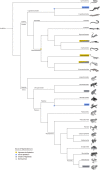Diverse Evolutionary Origins and Mechanisms of Lens Regeneration
- PMID: 29579253
- PMCID: PMC5995205
- DOI: 10.1093/molbev/msy045
Diverse Evolutionary Origins and Mechanisms of Lens Regeneration
Abstract
In this review, we compare and contrast the three different forms of vertebrate lens regeneration: Wolffian lens regeneration, cornea-lens regeneration, and lens regeneration from lens epithelial cells. An examination of the diverse cellular origins of these lenses, their unique phylogenetic distribution, and the underlying molecular mechanisms, suggests that these different forms of lens regeneration evolved independently and utilize neither conserved nor convergent mechanisms to regulate these processes.
Figures




References
-
- Agarwal LP, Angra SK, Knosla PK, Tandon HD.. 1964. Lens regeneration in mammals: II Monkeys. Orient Arch Opthalmol. 2:47–59.
-
- Ang SJ, Stump RJ, Lovicu FJ, McAvoy JW.. 2004. Spatial and temporal expression of Wnt and Dickkopf genes during murine lens development. Gene Expr Patterns 43:289–295. - PubMed
-
- Arresta E, Bernardini S, Gargioli C, Filoni S, Cannata SM.. 2005. Lens-forming competence in the epidermis of Xenopus laevis during development. J Exp Zool. 303A1:1–12. - PubMed
-
- Barbosa-Sabanero K, Hoffmann A, Judge C, Lightcap N, Tsonis PA, Del Rio-Tsonis K.. 2012. Lens and retina regeneration: new perspectives from model organisms. Biochem J. 4473:321–334. - PubMed
-
- Belecky-Adams TL, Adler R, Beebe DC.. 2002. Bone morphogenetic protein signaling and the initiation of lens fiber cell differentiation. Development 12916:3795–3802. - PubMed
Publication types
MeSH terms
Grants and funding
LinkOut - more resources
Full Text Sources
Other Literature Sources

